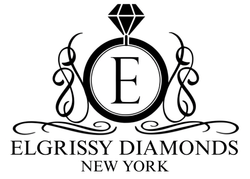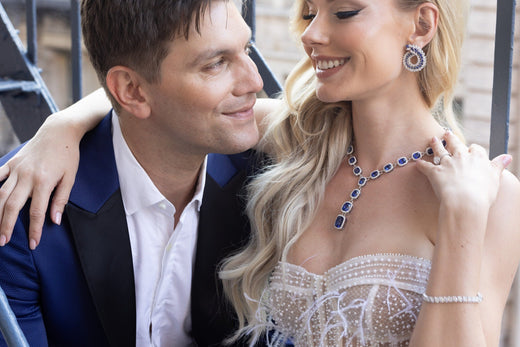A wedding is not just a union of two souls but also an expression of their shared journey and style. One of the most visually impactful ways to symbolize this unity is through the coordination of the bride’s and groom’s jewelry. Thoughtfully chosen, coordinated jewelry not only enhances the overall aesthetic of the wedding but also creates a harmonious, memorable look that reflects the couple's bond. From matching metals and gemstones to aligning with personal styles and wedding themes, this guide is designed to help couples achieve a balanced and elegant look that symbolizes their love and connection.
Why Coordinated Jewelry Matters
Coordinated jewelry between the bride and groom is more than just a fashion statement—it is a powerful symbol of unity and harmony. Matching or complementary pieces can reflect the couple's connection and shared commitment, making them feel more in sync on their special day. These subtle details demonstrate how two individuals come together to create something greater, a sentiment beautifully captured through their accessories.
A well-coordinated look not only enhances the couple’s appearance but also ties the wedding theme together seamlessly. When the bride’s and groom’s jewelry complements each other, it creates a visual harmony that resonates with the overall mood of the celebration. Whether the theme is classic elegance, bohemian chic, or modern minimalism, unified jewelry choices help elevate the style of the wedding and ensure stunning photographs to cherish forever.
Factors to Consider When Coordinating Jewelry
Personal Style Alignment
Every couple has their own unique style, and this individuality should shine through in their wedding jewelry. The key is finding a balance that respects both partners’ preferences while ensuring a cohesive look. For instance, if one partner prefers minimalist designs and the other leans toward ornate details, choosing subtle elements that bridge these styles—like shared metal tones or matching gemstones—can create harmony without compromising individuality.
Metal Consistency
Consistency in metal type is one of the easiest ways to achieve a coordinated look. Whether you choose classic yellow gold, sleek platinum, or romantic rose gold, using the same metal for both the bride’s and groom’s jewelry ensures visual unity. This choice also aligns well with other wedding elements, such as the rings, ensuring everything feels part of the same story.
Gemstone Coordination
Incorporating gemstones that complement each other is another effective strategy for coordination. For example, the bride’s diamond earrings could be mirrored in the groom’s cufflinks, or her sapphire necklace might echo the shade of the groom’s tie pin. Even subtle color matches can make a significant impact, tying together the couple's looks effortlessly.
Design Elements and Motifs
Coordinating design elements—such as floral patterns, geometric shapes, or vintage-inspired details—can add a thoughtful touch. This approach works particularly well if the couple has chosen a wedding theme, as the jewelry can reflect and reinforce these motifs. For example, a rustic wedding might feature natural, leaf-like designs, while an art deco celebration could inspire bold, geometric patterns.
Key Strategies for Coordinating Jewelry
Matching Wedding Bands
Wedding bands are a timeless symbol of unity, making them an ideal starting point for coordination. Many jewelers offer matching or complementary wedding ring sets designed specifically for couples. These sets may feature shared design elements, such as similar engravings, patterns, or gemstones, while allowing for subtle variations that reflect each partner’s individual style. For example, a bride’s ring might include delicate diamonds, while the groom’s version has a more minimalist design with the same metal and finish.
Complementary Accessories
Coordinating beyond wedding bands adds a layer of elegance and creativity to the couple’s overall look. Thoughtfully chosen accessories can mirror design elements or color palettes, enhancing the connection between the bride and groom.
-
For the Bride: Earrings, necklaces, or bracelets can subtly incorporate colors or materials present in the groom’s attire, such as the metal of his cufflinks or the hue of his tie.
-
For the Groom: Accessories like cufflinks, tie bars, or watches can be designed to echo the bride’s jewelry. For example, cufflinks adorned with the same gemstones as the bride’s earrings or necklace can create a subtle but effective link.
Engraved Personalization
Personalized engravings are a meaningful way to add a unique and intimate connection to your jewelry. Consider engraving a shared message, initials, or a significant date on both the bride’s and groom’s accessories, such as inside their wedding bands or on the back of a watch. This subtle detail ties the couple’s pieces together while adding sentimental value.
Balanced Proportions
When coordinating jewelry, it’s important to maintain balance. If the bride’s jewelry is bold and elaborate, the groom’s pieces should complement without overwhelming the overall look. Conversely, if the bride opts for a minimalist style, the groom’s accessories should align with that understated elegance. The goal is to create harmony, where neither partner’s style overpowers the other.
Aligning Jewelry with the Wedding Theme
Color Coordination
One of the simplest ways to align jewelry with a wedding theme is through color coordination. Incorporating the wedding’s color palette into the jewelry ensures a unified aesthetic. For example, if the wedding features a pastel theme, gemstones like aquamarine, morganite, or light sapphire could complement the attire. Similarly, a bold jewel tone wedding might inspire emeralds or rubies for the bride’s and groom’s accessories. Subtle touches, such as matching the bride’s necklace to the groom’s pocket square or tie, can create a seamless visual flow.
Style and Theme Harmony
Jewelry should enhance the chosen wedding theme, whether it’s a classic, bohemian, or modern style. For a vintage-inspired wedding, the bride and groom might choose antique or heirloom jewelry with intricate details, such as filigree or milgrain designs. A minimalist, contemporary wedding might call for sleek, simple jewelry pieces in clean geometric shapes. Ensuring that both partners’ jewelry reflects the same theme helps create a cohesive and polished look.
Reflecting Attire Details
Jewelry should complement the bride’s dress and the groom’s suit to achieve a harmonious balance. For example:
-
If the bride’s dress features lace or floral embroidery, her jewelry might incorporate floral motifs, mirrored subtly in the groom’s cufflinks or tie pin.
-
If the groom wears a suit with metallic accents, the bride’s jewelry could match the metal’s tone, such as gold or silver. Coordinating these small details ties the couple’s attire together and enhances the wedding’s overall aesthetic.
Cultural or Traditional Influences
Many weddings are enriched by cultural or traditional elements, and jewelry can play a significant role in honoring these roots. Couples might choose designs that reflect their heritage or incorporate meaningful symbols. For example, Indian weddings often feature gold jewelry and intricate patterns, while Celtic weddings may include designs like the Claddagh or knot motifs. Aligning the jewelry with these cultural elements adds depth and meaning to the couple’s look.
Practical Tips for Coordinating Couple’s Jewelry
Consult with a Professional Jeweler
Seeking advice from a skilled jeweler can make the coordination process seamless. Professionals can guide couples in selecting or designing jewelry that aligns with their vision, personal styles, and wedding theme. Many jewelers offer bespoke services, allowing couples to create custom pieces that reflect their unique bond while maintaining harmony in design and materials.
Schedule Fittings and Trial Sessions
Just as couples schedule attire fittings, jewelry trial sessions are equally important. Seeing how the bride’s and groom’s accessories complement each other in real time ensures that the overall look achieves the desired balance and cohesion. These fittings also provide an opportunity to adjust any mismatched elements before the wedding day.
Balance Individuality with Cohesion
While coordination is essential, it’s equally important to respect each partner’s personal style. The goal is not identical pieces but complementary ones that reflect the couple’s shared aesthetic. For example, if the bride prefers bold statement jewelry and the groom opts for a minimalist approach, the couple could incorporate shared elements, such as the same metal type or gemstone, to tie their looks together.
Plan Around the Wedding Timeline
Coordinating jewelry requires careful timing to avoid last-minute stress. Couples should start the process early, especially if custom or bespoke designs are involved. Factor in time for consultations, adjustments, and ensuring that all pieces are ready well before the wedding date.
Prioritize Comfort
On such a long and memorable day, comfort is key. Ensure that all jewelry pieces are easy to wear, especially for the groom, who might not be accustomed to wearing accessories like cufflinks or tie pins. Lightweight, non-restrictive designs can ensure the couple remains comfortable while looking their best.
Trends in Coordinated Wedding Jewelry
Modern Matching Sets
In recent years, many couples have embraced the idea of matching jewelry sets that are designed to complement each other. These sets often include subtle, shared design elements, such as matching patterns, metals, or engraving details. For example, sleek, minimalist designs with geometric shapes or intertwined motifs are becoming increasingly popular for modern weddings. These styles offer a fresh take on tradition while maintaining an elegant and timeless appeal.
Personalized Jewelry
Customization has become a significant trend, with couples opting for personalized pieces that tell their unique story. This might include engraved messages, coordinates of a special location, or initials incorporated into the design. Personalized touches not only add sentimental value but also make the jewelry truly one of a kind.
Colorful Gemstones
While diamonds remain a classic choice, many couples are exploring the use of colorful gemstones to express individuality and tie in with their wedding’s color scheme. From sapphires and emeralds to less traditional stones like tourmalines and opals, colorful accents provide an opportunity for creative and memorable designs.
Sustainable and Ethical Jewelry
As sustainability becomes a priority for modern couples, there’s a growing demand for ethically sourced and eco-friendly jewelry. Conflict-free diamonds, lab-grown gemstones, and recycled metals are popular choices for couples who want their pieces to reflect their values. Many jewelers now specialize in creating stunning designs that are as ethical as they are beautiful.
Cultural Fusion
With the blending of traditions in multicultural weddings, many couples are choosing jewelry that reflects elements from both of their cultural backgrounds. For example, combining traditional Indian goldwork with Western minimalist styles creates unique designs that celebrate heritage and unity. This trend allows couples to honor their roots while creating something distinctly personal.
Coordinating jewelry for the bride and groom is a thoughtful way to create a harmonious and unified look on the wedding day. By considering factors like personal style, wedding theme, and modern trends, couples can select pieces that not only complement each other but also reflect their unique bond. Whether through matching metals, personalized touches, or a shared appreciation for ethical practices, these coordinated details make a statement that will be cherished forever.
Careful planning, expert guidance, and attention to detail ensure that the jewelry becomes a beautiful and meaningful part of the couple’s love story—one that shines as brightly as their commitment to each other.







